Remember our coverage of the truly monstrous bucket wheel excavator eating a bulldozer? We also wrote about Humongous Tunnel Boring Machines (nothing "boring" about these "dinosaurs") and World's Most Powerful Mobile Crane. This time at Dark Roasted Blend, we again take a look at some of the largest vehicles and machines ever constructed.
This is the largest digging machine in the world. The bucket-wheeler excavator is called Bagger 288 or Excavator 288, built by Krupp of Germany. This thing’s over 300 feet high, more than 700 feet long machine and is the largest land vehicle in the world at 13,500 tons:


The Crawler-Transporter is a tracked vehicle used to transport such enormous objects as the Saturn V rocket and the Space Shuttle. These were the largest tracked vehicles in the world until they were overtaken by the Bagger 288 excavator:


(images credit: Mischa Klement, MicroArtwork, Austria, MicroArtwork.com)
The TAKRAF RB293 is a German made giant bucket-wheel excavator. Used in mining operations in Australia, it is recognized as the largest and heaviest land vehicle:


The F60 is apparently the world's largest machine that can move. The cutting height is 60 meters, hence the name and at 502 meters long, this has been called the ‘lying Eiffel Tower’. This machinery is used in Germany for brown coal or lignite opencast mining:

(image credit: Gwilym Owen)
This gigantic machinery is used for placing enormous windmills in the North Sea:

(image credit: Tjeert. M)
This is the world’s biggest tunnel boring machine – 400 feet long, 51 feet in diameter and weighing 9.5 million pounds (left image below). The tunnel machine on the right was used to construct underground sections of the transit lines in Toronto:

(images via 1, 2)
While this one was used for transit tunnels in Seattle:

(image credit: Keith Seinfeld, KPLU)
The monstrous Liebherr T 282B is a large earth-hauling dump truck designed in Germany in 2004.
it became the biggest earth-hauling truck in the world, with the most advanced model driven by a 10.5 ton, 3650 hp, 90 liter diesel engine:

(image via)
Also by Liebherr, this extremely heavy duty hydraulic shovel is used in open pit mining:

(image via Power Step, under permission)
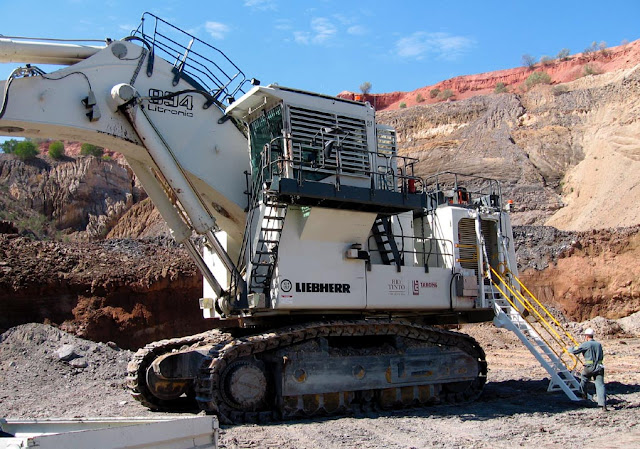
(image via)
This colossal machine called The Captain was built in 1965 and was the world’s largest power shovel, until it was scrapped in 1992. The bucket could hold 300 tons of material and at 28 million lbs this was the heaviest land vehicle ever built and one of the two largest land-based mobile machines ever constructed:
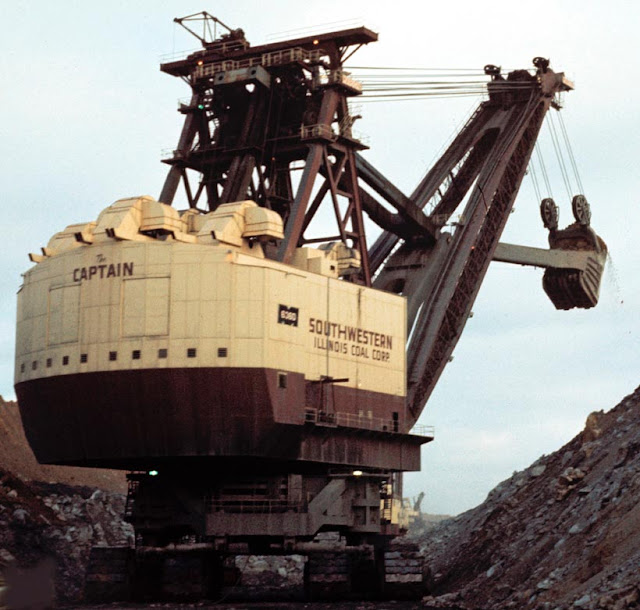
(image via)
The Bucyrus-Erie 1850B, built in 1962 at a cost of $6.5 million, is also known as Big Brutus, and it certainly is big. 160 feet tall and weighing 11 million lbs, the bucket could carry 150 tons of material and not surprisingly the machine had a maximum speed of just 0.22 mph. This machine isn’t the largest electric shovel ever built, but it is the largest electric shovel still in existence. Big Brutus was in operation in the sixties and seventies and is now on display at a mining museum in West Mineral, Kansas:
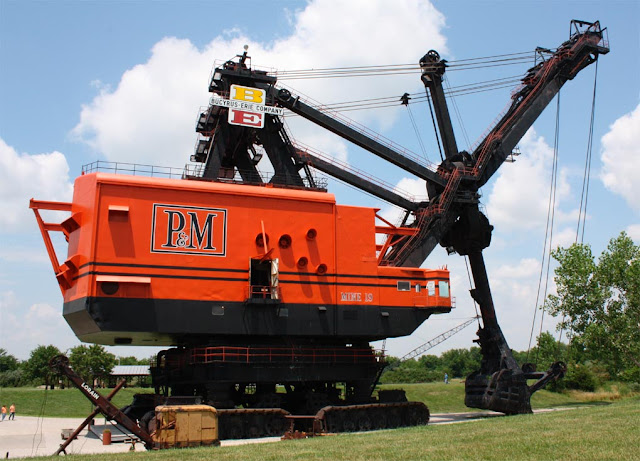

(images credit: Dale, 2)
The Big Bud 747 or 16-V 747 is the world’s largest farm tractor, weighing 100,000 lbs. This agricultural monster is 27 feet long, 20 feet wide and 14 feet high. It only travels at 8 mph, but is capable of cultivating 60 acres in an hour:
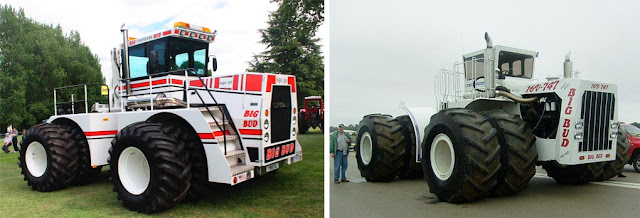
(images via 1, 2)
Here are some gigantic floating cranes in Japan - make sure to see our article Giant Floating Crane lifts Bridges:
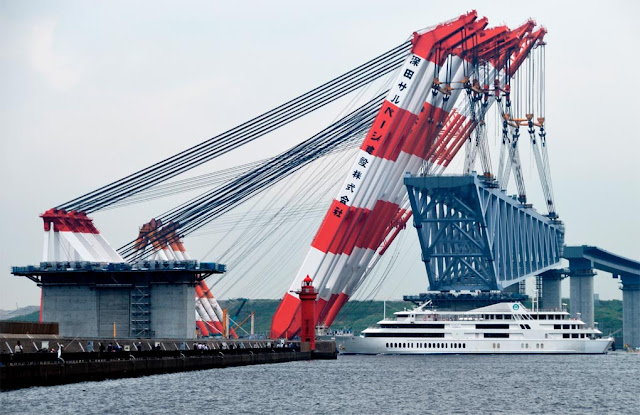
(image via)
The 4200 SM surface miner developed by Wirtgen of Germany weighs over 200 tonnes, is more than 30 m long and can cut up to 3,000 tonnes of material in an hour:
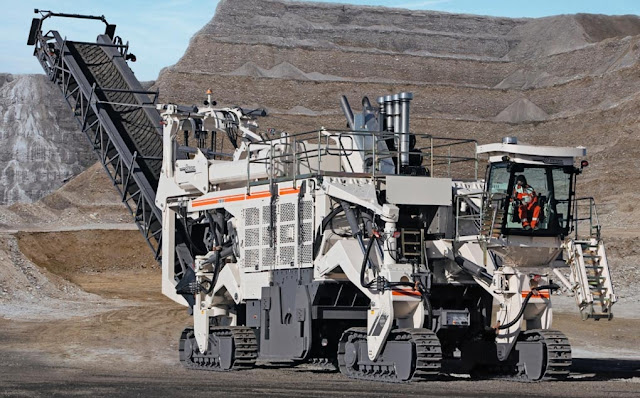
(image via)
And finally, here’s the Large Hadron Collider (LHC), the biggest and highest-energy particle accelerator in the world, designed to collide opposing particle beams. Constructed by the European Organization for Nuclear Research (CERN) and involving 10,000 engineers and scientists from universities and laboratories in more than 100 countries, the Collider is located underground on the France-Switzerland border near Geneva.
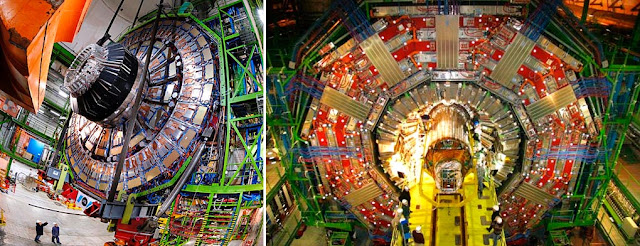
(images courtesy CERN, via)


The F60 is apparently the world's largest machine that can move. The cutting height is 60 meters, hence the name and at 502 meters long, this has been called the ‘lying Eiffel Tower’. This machinery is used in Germany for brown coal or lignite opencast mining:

(image credit: Gwilym Owen)
This gigantic machinery is used for placing enormous windmills in the North Sea:

(image credit: Tjeert. M)
This is the world’s biggest tunnel boring machine – 400 feet long, 51 feet in diameter and weighing 9.5 million pounds (left image below). The tunnel machine on the right was used to construct underground sections of the transit lines in Toronto:

(images via 1, 2)
While this one was used for transit tunnels in Seattle:

(image credit: Keith Seinfeld, KPLU)
The monstrous Liebherr T 282B is a large earth-hauling dump truck designed in Germany in 2004.
it became the biggest earth-hauling truck in the world, with the most advanced model driven by a 10.5 ton, 3650 hp, 90 liter diesel engine:

(image via)
Also by Liebherr, this extremely heavy duty hydraulic shovel is used in open pit mining:

(image via Power Step, under permission)

(image via)
This colossal machine called The Captain was built in 1965 and was the world’s largest power shovel, until it was scrapped in 1992. The bucket could hold 300 tons of material and at 28 million lbs this was the heaviest land vehicle ever built and one of the two largest land-based mobile machines ever constructed:

(image via)
The Bucyrus-Erie 1850B, built in 1962 at a cost of $6.5 million, is also known as Big Brutus, and it certainly is big. 160 feet tall and weighing 11 million lbs, the bucket could carry 150 tons of material and not surprisingly the machine had a maximum speed of just 0.22 mph. This machine isn’t the largest electric shovel ever built, but it is the largest electric shovel still in existence. Big Brutus was in operation in the sixties and seventies and is now on display at a mining museum in West Mineral, Kansas:


(images credit: Dale, 2)
The Big Bud 747 or 16-V 747 is the world’s largest farm tractor, weighing 100,000 lbs. This agricultural monster is 27 feet long, 20 feet wide and 14 feet high. It only travels at 8 mph, but is capable of cultivating 60 acres in an hour:

(images via 1, 2)
Here are some gigantic floating cranes in Japan - make sure to see our article Giant Floating Crane lifts Bridges:

(image via)
The 4200 SM surface miner developed by Wirtgen of Germany weighs over 200 tonnes, is more than 30 m long and can cut up to 3,000 tonnes of material in an hour:

(image via)
And finally, here’s the Large Hadron Collider (LHC), the biggest and highest-energy particle accelerator in the world, designed to collide opposing particle beams. Constructed by the European Organization for Nuclear Research (CERN) and involving 10,000 engineers and scientists from universities and laboratories in more than 100 countries, the Collider is located underground on the France-Switzerland border near Geneva.

(images courtesy CERN, via)

